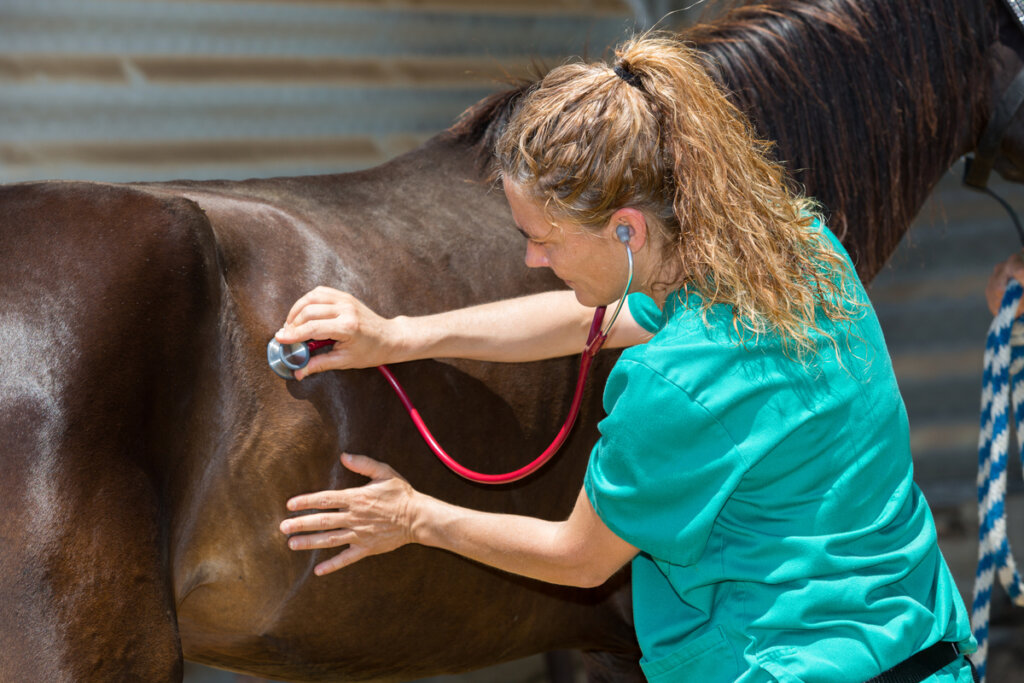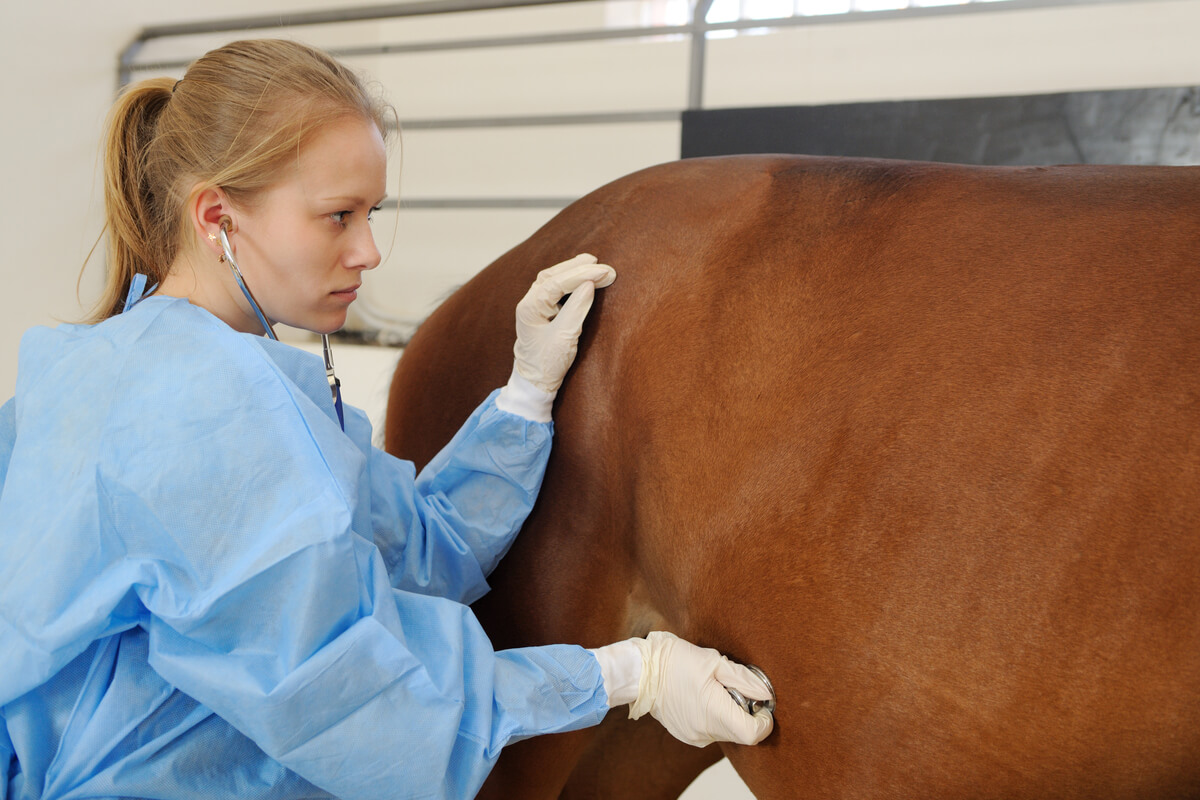What Is Equine Adenitis?

Equine adenitis, also known as equine distemper or strangles, is an infection of the horse’s upper respiratory tract, caused by the bacterium Streptococcus equi . In addition to this domestic species, the pathogen can affect other equids, such as ponies, donkeys and mules.
Equine adenitis is one of the most contagious illnesses in horses and is easily transmitted. In addition, it can be a zoonosis if the bacteria causing the disease is Streptococcus equi subsp. zooepidemicus, which can infect humans. In the following lines, we’ll tell you more about the medical condition of a horse suffering from equine adenitis.
Clinical signs of equine adenitis
The bacteria that cause adenitis enter the animal through the mouth and lodge themselves in the lymph nodes around the jaw. When this occurs, a sudden fever appears, followed by the typical clinical signs of a horse cold, such as a cough or discharge.
Gradually, the submandibular and retropharyngeal nodes — both located at the beginning of the horse’s throat — swell, form abscesses, and produce a mucopurulent discharge.
The condition often receives the name strangles because many horses that suffered from the disease suffocated, due to the lack of air as a consequence of having swollen glands.
The disease varies greatly from one animal to another. In older horses, it tends to have a mild onset, thanks to a well-developed immune system. On the contrary, young horses end up having a much more severe and difficult to heal lymph node condition.
The clinical signs of equine adenitis usually follow the following steps:
- Persistent fever, which is maintained until the full development of adenopathy.
- The appearance of anorexia and lack of appetite. Often the animal stands with its neck extended. Attempting to eat can cause food to flow back through the nostrils.
- Depression and apathy.
- Development of pharyngitis, laryngitis, and rhinitis.
- The appearance of nasal secretions, which can start out being serous and end up as purulent.
- If the animal doesn’t expel all the mucus through the nose, it will be heard in the upper tract. You will also see the appearance of mucus in the eyes.
- Development of adenopathy. The nodes become swollen and can stay that way for up to a week. The first clinical sign of adenopathy is the appearance of a warm, diffuse, and painful edema on the horse’s neck.

How is equine adenitis transmitted?
The main route of contagion of equine adenitis is direct contact between horses. A horse with active adenitis that is continuously secreting mucus is a major source of infection for susceptible animals of the same species – or genus.
Transmission occurs when a sick animal spits mucus onto a healthy animal. Horses, through their social behavior where head to head contact is totally normal, can easily get infected.
In addition, there’s an indirect way of getting infected: sharing the same box, the same feeder or the same drinking trough. The owner may also transmit the infection between the horses, when handling several at the same time.
On the other hand, some horses that are cured of the disease are still transmitters of the bacteria. This is known as a long-term ‘subclinical carrier’. This animal will continue to spread the pathogen, even if it appears not to have the disease.
It’s very important to continue collecting samples of secretions in recovered animals, to know when exactly they have stopped infecting.
Complications and treatments
As mentioned, this disease – despite being very contagious and annoying – doesn’t lead to high animal mortality. However, the development of abscesses in the lymph nodes of young animals can be very annoying and difficult to cure.
Ideally, all horses will suffer the infection as just another cold, where the lymph nodes are involved. Unfortunately, there’s a much worse complication that can be fatal in most cases.
In rare cases, abscesses develop in other organs of the body, something known as ‘bastard strangulation’. The spread of the abscess through the organism can occur through several routes, such as the blood, lymph nodes, or nerves. The most common areas for these abscesses are the lungs, liver, spleen, kidneys, and brain.
Another major complication is infection of the guttural pouches. These structures are diverticula related to a horse’s respiratory system that connect the Eustachian tubes with the pharynx. If this area becomes infected, in addition to clinical complications, the animal may be a carrier for much longer.
Given the diversity of cases, each animal usually has a different treatment. In general, almost all treatments start with only supportive care for the horse.
Observing how the animal evolves is essential, in addition to administering anti-inflammatories if it finds it difficult to swallow or if it has a fever. It’s also vital to provide a more humid and easy-to-swallow diet. Occasionally, some veterinarians will administer antibiotics to the animal patient. However, this depends a lot on the individual case.
For carrier animals there’s also a treatment. First of all, the horse will be isolated, to prevent it from infecting more animals. After that, the dry pus will be extracted from the guttural bags by endoscopy and the use of topical antibiotics within the same bags.

Equine adenitis can be a fatal disease, but only in isolated cases. Of course, it’s a very infectious pathology, so infected animals must always be isolated and cared for by professionals as soon as possible.
All cited sources were thoroughly reviewed by our team to ensure their quality, reliability, currency, and validity. The bibliography of this article was considered reliable and of academic or scientific accuracy.
- Boyle, A. G., Timoney, J. F., Newton, J. R., Hines, M. T., Waller, A. S., & Buchanan, B. R. (2018). Streptococcus equi infections in horses: guidelines for treatment, control, and prevention of strangles—revised consensus statement. Journal of veterinary internal medicine, 32(2), 633-647.
- Harrington, D. J., Sutcliffe, I. C., & Chanter, N. (2002). The molecular basis of Streptococcus equi infection and disease. Microbes and Infection, 4(4), 501-510.
- Sweeney, C. R., Benson, C. E., Whitlock, R. H., Meirs, D. A., Barningham, S. O., Whitehead, S. C., & Cohen, D. (1989). Description of an epizootic and persistence of Streptococcus equi infections in horses. Journal of the American Veterinary Medical Association, 194(9), 1281-1286.
- Taylor, S. D., & Wilson, W. D. (2006). Streptococcus equi subsp. equi (Strangles) infection. Clinical Techniques in Equine Practice, 5(3), 211-217.
- Arias Gutiérrez, M. P. (2013). Adenite: a doença respiratória infeciosa de maior prevalência em cavalos ao redor do mundo. CES Medicina Veterinaria y Zootecnia, 8(1), 143-159.
